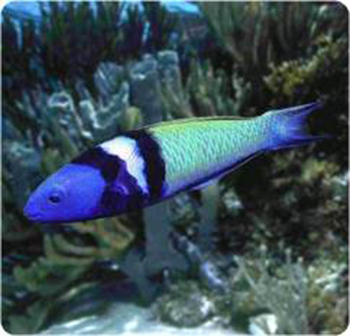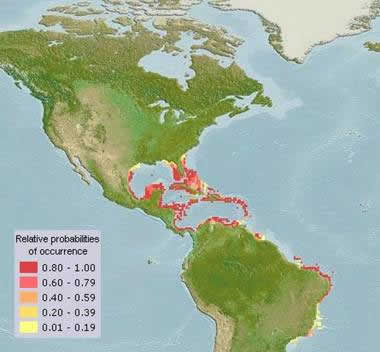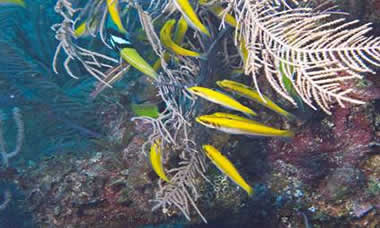Blue Head Wrasse
Thalassoma bifasciatum

Taxonomy
Super-Class: Osteichthyes
Class: Actinopterygii
Order: Perciformes
Family: Labridae
Fast Facts
Animal Type: Bony fish
Body Type: Cigar-shaped
Primary Diet: Carnivorous; Zooplankton
Maximum Size: 25 cm (9.8 in)
Depth Range: 0-40 m (0-131 ft)
Life Span: Up to 3 years

Range/Habitat
T. bifasciatum is a reef-dwelling fish found primarily throughout the Caribbean and Gulf of Mexico. They are found as far north as the Carolinas and as far south as Brazil. They frequent shallow reef areas, mangroves, and sea grass beds. They may occur in schools, especially when feeding. Juveniles are known to recede into sea anemones for protection from predation, but they must avoid the stinging tentacles and ingestion by the anemone (Bester).
Coloration
T. bifasciatum is a brightly colored fish with multiple possible color variations depending on stage of development. The juvenile phase is generally an overall yellow coloration, while the initial phase (IP) is characterized by a “dusky blue color with irregular white stripes” (Beletsky, 2010). Variations include dark spots or stripes and may depend on location. The most notable color phase is that of the supermale, or terminal phase (TP) male. These individuals have a bright blue head adjacent to a dark bar, white bar, another dark bar, and a blue-green or yellow-green body (Bester). Fins may have dark bars or spots as well.
Behaviors
Bluehead wrasses are carnivorous and usually feed on zooplankton, the eggs of other fish, and small bottom-dwelling organisms. Juveniles and initial phase individuals in particular may participate in cleaning stations, consuming dead material and parasites off of the bodies and out of the gills of larger fish as they pass through the station. Which food source they capitalize on depends largely on ocean current and reef condition (Oceana).
Predation
Predatory threats to the blue head wrasse include the trumpetfish, red hind, greater soapfish, and yellowfin grouper (Bester). They are not predated by humans, but may be used as baitfish.
Reproduction
Reproduction normally occurs toward the middle of the day when the IP fishes form large groups and release gametes into the water. The supermales form harems of courted females and reproduce with each female separately.
In the absence of dominant males, the larger females of the group can display sex reversal or change and replace the absent dominant males. This behavior is referred to as protogyny.
Bluehead wrasse harem

Conservation
The blue head wrasse is rated by the IUCN as an animal of least concern.
Research
Most research involving the blue head wrasse revolves around its ability to change sex. In a study by Robert Warner and Stephen Swearer, social control of sex change was studied. They found that “Overall, there was a very strong response to the removal of TP and [early terminal phase] males on the experimental reefs” (Warner). Following the removal of the TP males, it was always the largest individuals in the group that took their place as dominant males.
A study conducted by Koulish and Kramer explored the effect of human chorionic gonadotrophin (hCG) on protogynous fish. In 1-6 weeks, after treatment with hCG, 80% of the fish displayed signs of sex reversal (compared to 11% control) (Koulish).
Interesting Facts
- Unlike most fish, blue head wrasses swim mainly with their pectoral fins.
- They are a popular addition to salt water aquariums.
- Larvae bury themselves in the sand until they emerge as juveniles.
- Blue head wrasses are very bold and may approach humans in the water.
References
Beletsky, L. (2010). Belize and Northern Guatemala. Northampton: Interlink Books.
Bester, C. "Bluehead." Florida Museum of Natural History: Ichthyology. 2012. Florida Museum of Natural History. 27 May 2012 <http://www.flmnh.ufl.edu/fish/gallery/Descript/Bluehead/Bluehead.html>.
Computer Generated Map for Thalassoma bifasciatum (un-reviewed). www.aquamaps.org, version of Aug. 2010. Web. Accessed 29 May. 2012.
Koulish, S. and Kramer, C.R. (1989), Human chorionic gonadotrophin (hCG) induces gonad reversal in a protogynous fish, the bluehead wrasse, Thalassoma bifasciatum (teleostei, labridae). J. Exp. Zool., 252: 156-168. doi: 10.1002/jez.1402520207
Marine Wildlife Encyclopedia. 2012. Oceana. 27 May 2012 <http://oceana.org/en/explore/marine-wildlife/bluehead-wrasse>.
Warner, R.R. and Swearer, S.E. (1991), Social Control of Sex Change in the Bluehead Wrasse, Thalassoma bifasciatum (Pisces: Labridae). Biol. Bull. 181: 199-204. (October, 1991)